InterviewSolution
This section includes InterviewSolutions, each offering curated multiple-choice questions to sharpen your knowledge and support exam preparation. Choose a topic below to get started.
| 89901. |
A drug that is antipyretic as well as analgesic is |
|
Answer» penicillin |
|
| 89902. |
A drug that is antipyretic as well as analgesic is.... |
|
Answer» CHLORO promazine hydrocloride |
|
| 89903. |
A drug that is antipyretic as well as analgesic is : |
|
Answer» CHLOROQUINE |
|
| 89904. |
A drug that binds to the receptor site should inhibit its natural function is called .................. |
| Answer» SOLUTION :ANTAGONISTS | |
| 89905. |
A drug effective in the treatment of pneumonia, bronchitis etc is ......... |
|
Answer» streptomycin |
|
| 89906. |
A drug effective in the treatment of pneumonia,bronchities,etc,is: |
|
Answer» Streptomycin |
|
| 89907. |
An antibiotic effective in treatment of pneumonia, bronchitis etc. is |
|
Answer» Sulphaguanidine |
|
| 89908. |
A drop of solution (volume 0.05 mL) contains3.0xx10^-6mole of H^+If the rate constant of disappearance ofH^+ is10^7mol litre^-1 sec^-1 How long would it take for H^+ in drop to disappear : |
|
Answer» `6xx10^-8sec`. |
|
| 89909. |
A drop of a solution (volume 0.05 mL) contains 3.0xx10^(-6) mole of H^(+) ions. If the rate constant of disappearance of H^(+) ions is 1.0xx10^(-7)" mol L"^(-1)s^(-1), how long would it take for H^(+) ions in the drop to disappear ? |
|
Answer» Solution :As the units of RATE constant are `"mol L"^(-1)s^(-1)`, this means disappearance of `H^(+)` ions is a reaction of zero order. For `100%` reaction to COMPLETE (i.e., complete disappearance of `H^(+)` ions) `t_(100%)=([A]_(0))/(K)=([H^(+)])/(k)` 0.05 mL of the DROP contains `H^(+)` ions `=3.0xx10^(-6)` mole `:.100" mL of the solution will contain "[H^(+)]=(3.0xx10^(-6))/(0.05)xx1000=6xx10^(-2)` i.e., `[H^(+)]=6xx10^(-2)" M"` `:.t_(100%)=(6xx10^(-2))/(1xx10^(7))=6xx10^(-9)s` |
|
| 89910. |
A drop of a solution (v=0.05ml) contains 6xx10^(-7) moles of H^(+). If the rate constant of disappearance of H^(+) is 6xx10^(5) mole L^(-1)S^(-1) it takes X xx 10^(-8)s for H^(+) in the drop to disappear X is |
|
Answer» `[1.2xx10^(-2)""-0]=6XX10^(5)(x xx10^(-8)),x=2` `ATOB` `1""0` |
|
| 89911. |
Draw the cis and trans isomers of [Pt(NH_(3))_(2)Cl_(2)]. |
Answer» SOLUTION :(a).  (B) FOUR IONS |
|
| 89912. |
(a) Draw the structures of the following molecules : (i) H_(3)PO_(2) (ii) CIF_(3) (b) Explain the following observations : (i) Nitrogen is much less reactive than phosphorus. (ii) Despite having greater polarity, hydrogen fluoride boils at a lower temperature than water . (iii) Sulphur has greater tendency for catenation than oxygen in the same group. |
Answer» Solution :(i) `H_(3)PO_(2)` 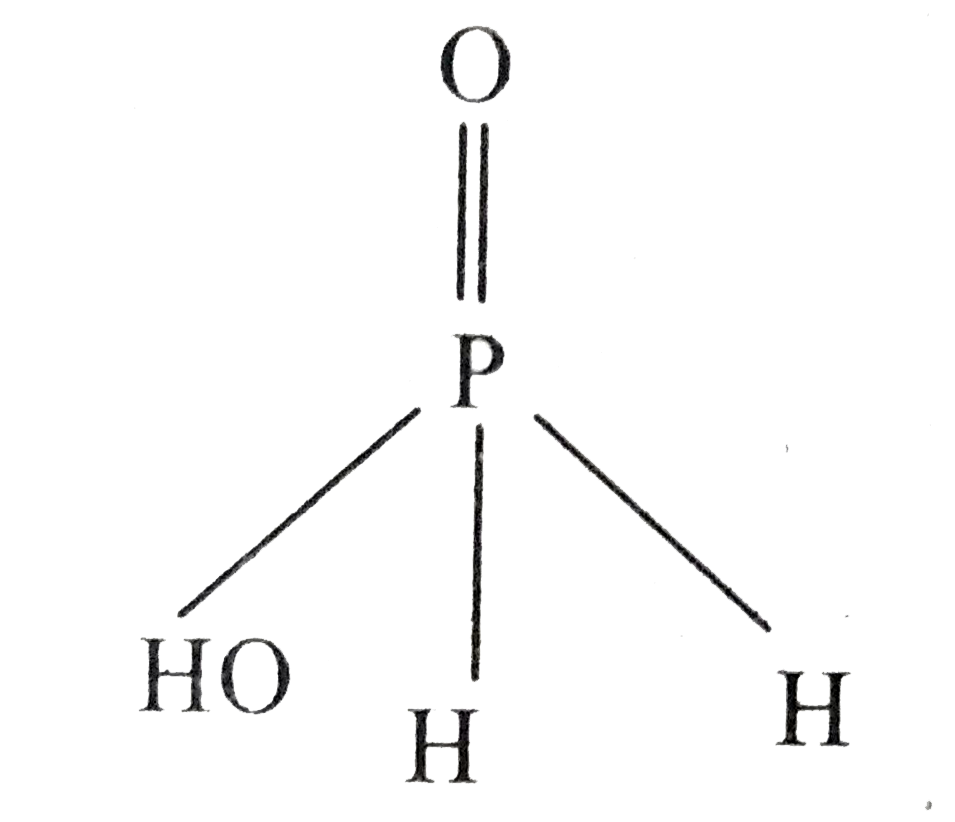 (ii) `CIF_(3)` : Structure of `ClF_(3)`(g) 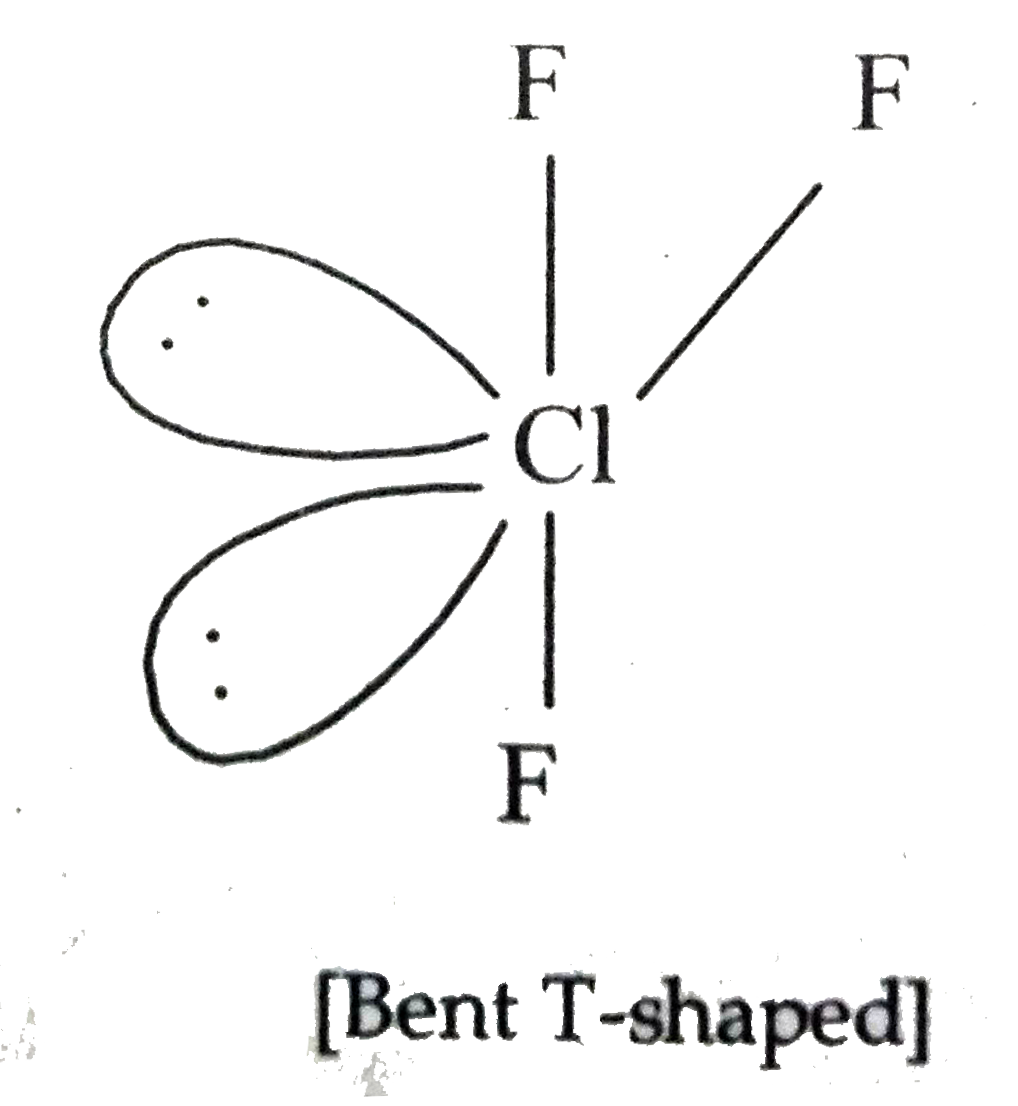 (B) (ii)Water molecules has twice as many Hydrogen bonding does HF and therefore more INTERMOLECULAR ATTRACTION and HIGHER boiling point than HF. |
|
| 89913. |
(a) Draw the structure of XeF_2 and BrF_3 (b) Give the structures of white phosphorus and red phosphorus |
Answer» SOLUTION :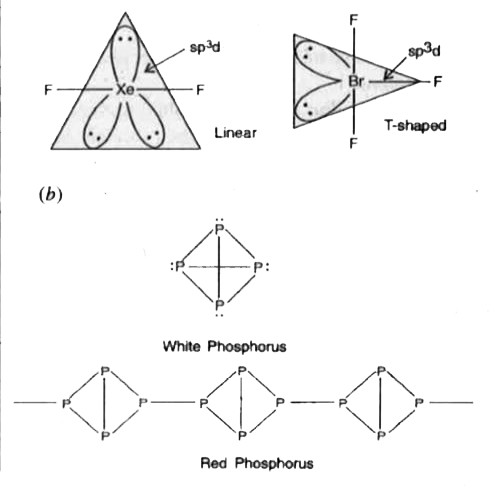
|
|
| 89914. |
(a) Draw the structure of following: (i) XeF_6 (ii) XeOF_4(b ) Describe the Haber process for manufacture of ammonia. |
|
Answer» Solution : (b )Haber.sprocess for themanufactureof `NH_3`( by synthesis ) ` UNDERSET((G)) N_2+underset((g))3H_2hArrunderset((g)) 2NH_3DeltaH=- 92.4 KJ` Accordingto Lechatelier.sprinciple . the favourableconditionsfor themanufactureof `NH_3`are LOWTEMPERATURE(700 K )HIGHPRESSURE( 400-600 atm) andpresenceof acatalyst`Fe_2 O_3 //Mo ` `N_2` and`H_2` Are mixedin theratio1:3by volumeandcompressedto apressureof 400 - 600 atmand thenpassedthrough catalystchamber at 700K, here`NH_3` is producedwhichis codensedto getliquid`NH_3`theunreachedgasesare mixedwithmoreof `N_2`and `H_2`compressedand passedthroughcatalystchamber . |
|
| 89915. |
(a) Draw the structure of following (i) XeF_6 (i) XeOF_4 Describethe harber process for manufacture of ammonia |
Answer» Solution :(a) Structure of (b) Haber.s process for the manufacture of` NH_3`(By synthesis) `N_2(g) + 3H_2(g) iff 2NH_3 (g) "" Delta H = -92.4 kJ` According to Lechatelier.s principle, the favourable CONDITIONS for the manufacture of `NH_3`are low temperature (700 K), HIGH pressure (400-600 atm) and presence of a catalyst `Fe_2O_3//Mo` `N_2` and `H_2` are mixed in the ratio 1 : 3 by volume and compressed to a pressure of 400-600 atm and then passed through catalyst chamber at 700 K. Here `NH_3`is PRODUCED which is condensed to GET liquid `NH_3` . The unreacted gases are mixed with more of `N_2`and `H_2` , compressed and passed through catalyst chamber. |
|
| 89916. |
(a) Draw Newman's projection for the stable staggered form of butane. (b) Relatively less stability of the staggered form is due to (i) Torsional strain (ii) van der Waals' strain (iii) Combination of the above two |
| Answer» | |
| 89917. |
Draw a neat labeled diagram of Standard Hydrogen Electrode (SHE). Write itsHalf-Cell reaction. |
Answer» Solution : The SHE is represented as `Pt(s)//H_(2)" (G, 1 bar)"//H^(+)(aq.1M)and E^(@)` value is zero. |
|
| 89918. |
A double salt which contains fourth period alkali metal (A) on heating at 500K gives (B). Aqueous solution of (B) gives a red colour compound with alizarin. Identify A and B. |
|
Answer» Solution :(i) A double SALT which contains `4^("th")` period alkali METAL (A) is `K_(2)SO_(4).Al_(2)(SO_(4))_(3).24H_(2)O` (ii) `K_(2)SO_(4)Al_(2)(SO_(4))_(3).24H_(2)O overset(500K)to K_(2)SO_(4)Al_(2)(SO_(4))_(3)+24H_(2)O` (iii) `:.` B is `K_(2)SO_(4).Al_(2)(SO_(4))_(3)`. This gives white PRECIPITATE with `BaCl_(2)`. (iv) `K_(2)SO_(4).Al_(2)(SO_(4))_(3)` gives red colour with Alizarin. (v) `A-K_(2)SO_(4).Al_(2)(SO_(4))_(3)24H_(2)O` `B-K_(2)SO_(4).Al_(2)(SO_(4))_(3)`. |
|
| 89919. |
A double salt which contains fourth period alkali metal (A) on heating at 500 K gives (B). Aqueous solution of (B) gives white precipitate with BaCl_(2) and gives a red colour compound with alizarin. Identify A and B. |
|
Answer» SOLUTION :(i) A double salt which contains FOURTH period alkali metal (A) is potash alum `K_(2)SO_(4).Al_(2)(SO_(4))_(3).24H_(2)O` (ii) On heating potash alum (A) 500 kgive anhydrous potash alum (or) burnt alum (B) `K_(2)SO_(4).underset((A))underset(("Potash alumn"))(Al_(2)(SO_(4))_(3).24H_(2)O)overset(500 K)(to) underset((B))underset(("Burnt alum"))(K_(2)SO_(4).Al_(2))(SO_(4))_(3)+24H_(2)O` (iii) Aqueous solution of burnt alum, has sulphates ion, potassium ion and aluminium ion. SULPHATE ion reacts with `BaCl_(2)` to form white precipitate of Barium sulphate, `(SO_(4))^(2-)+BaCl_(2)toBaSO_(4)+2Cl^(-)` Aluminium ion reacts with alizarin solution to GIVE a red colour compound. |
|
| 89920. |
A diver quickly ascends to the surface of the water from a depth of 4.08 m withoutexhaling out the air in her lungs. By what factor would the volume of her lungs increase by the time she reaches the surface? Assume constant temperature and ideal gas behaviour. The density of sea water is 1.03 g/cc and g = 980.67 cm s^(-2) . |
| Answer» SOLUTION :1.4 TIMES | |
| 89921. |
A diver at a depth of 45 m exhales a bubble of air that is 1 cm in radius, Assumingideal gas behaviour, what will be the radius of this bubble as it breaks at the surface of the water? |
|
Answer» Solution :`p_1 = rhogh +` ATM . PRESSURE , `P_2` = atm. Pressure APPLY `p_1V_1 = p_2V_2`, calculate `V_2` and then the radius 1.8cm |
|
| 89922. |
A ditute aqueous solution of sodium fluoride is electrolysed, the products at the anode and cathode are: |
|
Answer» `O_2,H_2` |
|
| 89923. |
(A) Ditertiarybutyl ether cannot be prepared by Williamson's synthesis(R) Ter.butylbromide on reaction with tertiary butoxide preferably undergo elimination |
|
Answer» Both (A) and (R) are TRUE and (R) is the correct EXPLANATION of (A) |
|
| 89924. |
a. Distinguish between 1^(@),2^(@), and 3^(@) amines by using succine anhydride (A). b. What are the limitations of Hinsberg reagent? c. Give the structural formula of a chiral compound C_(8)H_(11)N(X), which dissolves in dilute HCl and evolves N_(2) gas with HNO_(2). |
Answer» Solution :  (iii) `3^(@)` amine does not REACT with `(A)`, the unreacted amine dissolve in aqueous ACID `(H_(3)O^(o+))`. b. The amines must be water-insoluble liquids. C. `D.U.` in `(X)=((2n_(C)+2)-(n_(H)-n_(N)))/(2)=(18-10)/(2)=4^(@)` (i) `4 D.U.` in `(X)` suggests that it CONTAINS benzene ring. (ii) `(X)` is a `1^(@)` amine SINCE it dissolve in `HCl` and gives `N_(2)` with `HNO_(2)`. (iii) The remaning `C` atom the `NH_(2)` must form a chiral molecule. So, `(X)` is : 
|
|
| 89925. |
A distinctive and characteristic functional group of fats is |
|
Answer» a PEPTIDE group 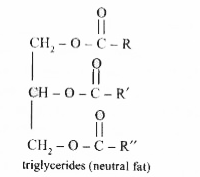
|
|
| 89926. |
A distinctive and characteristic functional group in fat is : |
|
Answer» KETO group |
|
| 89927. |
A dispersion of tiny droplets of one liquid in another is called: |
|
Answer» Gel |
|
| 89928. |
A disease can often be transmitted by polluted water is: |
|
Answer» Rabies |
|
| 89929. |
(a) Discuss the important physical properties of carboxylic acids. (b) Discuss the structure of carboxylic acids. How do you account for acidic character of carboxylic acids ? |
|
Answer» Solution :(a) Physical properties of carboxylic acids. The important physical properties of carboxylic acids are given ahead : (i) The FIRST three members of the carboxylic acids are colourless and have pungent smell. The next six members are oily liquids with a faint unpleasant odour. Thereafter, they are colourless waxy solids. Benozic ACID and its homologues are colourless solids. (ii) The first four members are very soluble in water and the solubility decreases gradually with the rise of molecular mass. However, all are soluble in alcohol or ether. Benzoic acid is sparingly soluble in cold water but is soluble in hot water, alcohol, ether. (iii) Lower carboxylic acids (upto `C_(10)`) are volatile in steam while higher members are non-volatile. (iv) They have higher boiling points than the corresponding alcohols of COMPARABLE molecular masses. This is due to the fact that a pair of carboxylic acid molecules (known as dimers) are held together not by one but by two hydrogen bonds :  (b) Structure of carboxylic acids. Carboxylic acid is planar molecule in which the carbon atom of carbonyl group  is `sp^(2)` hybridised. It is bonded to the oxygen atom of OH group and the carbon atom (or H atom) with the help of `sigma` bonds. It is a resonance hybrid of the following structures : is `sp^(2)` hybridised. It is bonded to the oxygen atom of OH group and the carbon atom (or H atom) with the help of `sigma` bonds. It is a resonance hybrid of the following structures :  It is clear that in the resonance hybrid (structure II) the oxygen atom of a hydroxyl group carries some positive charge. Consequently, the ELECTRON pair of the O-H bond is displaced towards oxygen atom. This displacement of electron causes the release of a proton and a carboxylate ion, `RCOO^(-)`, is formed. Carboxylate ion The carboxylate ion thus formed is also a resonance hybrid of structures III and IV as shown below : Thus, we observe that carboxylic acid as well as its anion are resonance stabilised. However, we compare these structures, we observe that carboxylic acid stabilised) structures (I and II) are not cquivalent while carboxylate ion structures (III and IV) are equivalent. Therefore, the carboxylate ion is more resonance stabilised by the resonance. Thus, carboxylic acids READILY give proton to form more stable carboxylate ion. |
|
| 89930. |
(a) Discuss the structural relationship of water , alcohol and ethers. (b) Compare the bond angles of H-O-H,C-O-H fo alcohol and C-O-C of ethers. (c ) What is crown ether ? How is it named ? 9d) What is absoluteether ? (e ) Compare the following alkyl halides in decreasingorder of reactivity in the Williamson's reaction : ClCH_(2)CH_(2)CH_(3)(A),""BrCH_(2)CH_(2)CH_(3)(B), (CH_(3))_(3)C C H_(2)Br(C ),""ClCH_(2)CH=CH_(2)(D) (f) Give six types of ethers and cannot be synthesised by the typical Williamson's reaction. |
|
Answer» Solution :[Hint] (i) Alcohols and ethers may be regarded as derivatives of H-O-H . The replacement of one H atom affords alcohols, ROH. In ethers both hydrogen atoms are replaced. (ii) In all the three cases, oxygen undergoes `sp^(3)` -hybridization, there is contraction in the bond angle , which is `105^(@)`. The bond angle is very close to `109^(@)`in alcohols. The C-O-C bond angle in ethers is about `110^(@)` on account of repulsive van der Waals' forces between groups of larger size. (iii)The heterocyclic polyether is called crown ether. It is named on the basis of total number of atoms in the ring and number of oxygen atoms. [15] crown -5 MEANS 15 atoms inthe ring including 5 oxygen atoms. (iv) Absolute ether means diethyl ether absolutely free from water. (V) `underset(("Allylic"))(D) gtunderset(("Bromide"))(B)gtunderset(("Chloride"))(A)gtunderset(("NEOPENTYL"))(C)` (vi)(i) `R_(3)C-O-CR_(3)`(Both c atoms are `3^(@))` (ii) `R_(2)CH-O-CHR_(2)`(Both C atoms are `2^(@))` (iii) `R_(3)C-O-CHR_(2)`(One C is `3^(@)` and one is `2^(@))` (iv) `Ar-O-Ar `(Both are aryl groups ) (v) `RCH=CH-O-CH=CHR'` (Both are vinyl groups ) (vi) `R_(3)C C H_(2)-O-CH_(2)CR_(3)` ( Both are neopentyl groups ) (vii) `RCH=CH_(2)+R'OHunderset((ii)NaBH_(4))OVERSET((i)Hg(OOC CF_(3))_(2))(rarr)Runderset(OR')underset(|)(C)H -underset(H)underset(|)(C)H_(2)` |
|
| 89931. |
Discuss the mechanism ofhydrolysis of tert - butyl bromide. |
|
Answer» Solution :Tertiary alkyl halides, undergo `SN^(1)` reaction. `SN^(1)` MECHANISM follows FIRST order kinetics. Example : Tertiary butyl bromide on hydrolysis with aqueous `NaOH` gives tertiary butyl alcohol. `underset("(Tertairy butyl bromide)")(CH_(3)-overset(CH_(3))overset("|")underset(CH_(3))underset("|")"C "-Br+NaOH)rarr underset("(Tertiary butyl alcohol)")(CH_(3)-overset(CH_(3))overset("|")underset(CH_(3))underset("|")"C "-OH+NaBr)` Mechanism :- I STEP : (slow step) Tertiary butyl bromide ionises slowly to give `Sp2` hybridised PLANAR tertiary butyl carbocation and bromide ion  II Step : (FAST step) The nucleophile `OH^(-)` from aqueous `NaOH` attacks planar carbocation on either side to give tertiary butyl alcohol 
|
|
| 89932. |
(a) Discuss the electrochemical theory of corroison (b) For the reaction Ni(s)+2Ag^(+)(1M) to Ni^(2+)(1M)+2Ag(s) Which species gets reduced ? |
|
Answer» Solution :(a) For ANSWER, consult Section 23. (B) `Ag^(+)` IONS GET reduced to Ag. |
|
| 89933. |
(a) Discuss briefly the following reactions : (i) Gattermann Koch reaction (ii) Rosenmund reaction. (b) Trichloro acetic acid is stronger acid than dichloro acetic acid. Explain. |
Answer» Solution :(a) (i) Gattermann Koch reaction. BENZENE on passing through a mixture of carbon monoxide and hydrochloric acid gas in the presence of anhydrous `AICI_(3)` and traces of cuprous chloride is converted to benzaldehyde by this reaction.  It is modified form of Friedel-Crafts reaction in which -CHO GROUP is introduced in the benzene ring. (II) Rosenmund.s reaction. Acid chloride on reacting hydrogen in the presence of palladium suspended over barium SULPHATE and poisoned with sulphur or quinoline gets converted to an aldehyde by this reaction.  `CH_(3)COCl+H_(2) overset(Pd. BaSO_(4))to underset("Ethanol")(CH_(3)CHO)+HCl` (b)  Due to the presence of more number of electron withdrawing groups in trichloroacetic than dichloroacetic acid, the-Inductive effect causes the electron withdrawal more strongly towards oxygen of O-H bond and promotes the release of `H^(+)` ions more effectively. Thus trichloroacetic is more acidic than dichloro acetic acid. |
|
| 89934. |
A disaccharide 'X' on hydrolysis gives two C-epimeric monosaccharides 'Y' and 'Z'. Then what is 'X'? |
| Answer» SOLUTION :Glucose and GALACTOSE are `C_(4)^(-)` EPIMERS. X = Lactose. It undergose HYDROLYSIS to give glucose (Y) and galactose (Z). | |
| 89935. |
A disaccharide on hydrolysis gives |
|
Answer» TWO molecules of the same monosaccharide |
|
| 89936. |
[A] : Dipole moment of pyridine is greater than pyrrole but in opposite direction. [R] : In pyrrole N atom contributes two electrons for delocalized pi-orbitals but this is not true for pyridine. |
|
Answer» ASSERTION is correct but not REASON |
|
| 89937. |
A direct current deposits 54 g of silver (atomic mass = 108u) during an electrolysis process. How much aluminium would be deposited from aluminium chloride solution by the same amount of electricity? |
| Answer» Answer :A | |
| 89938. |
(A): Direct absorption of SO_(3) in H_(2)O is commercially not possible (R): Direct absorption of SO_(3) in water forms a mist of corrosive vapours. |
|
Answer» Both (A) and (R ) are trueand (R ) is the CORRECT EXPLANATION of (A) |
|
| 89939. |
(A) Diphenyl ether is prepared by Ulmann reaction as shown below : C_(6)H_(5)ONa+BrC_(6)H_(5)underset(483K)overset(Cu)(rarr)C_(6)H_(5)-O-C_(5)H_(5)+NaBr (R ) Diphenyl ether is used as perfume. |
|
Answer» If both (A) and (R ) are CORRECT and (R ) is correct EXPLANATION of (A ). |
|
| 89940. |
A dipetide on hydrolysis gives two amino acids. (A)NH_(2)underset(R )underset(|)(C )HCOOH and (B)H_(2)Nunderset(R')underset(|)(C )HCOOH The dipetide is also hydrolyses by leucine amino peptidase enzyme giving amino acid (B). What is the structure of dipeptide? |
Answer» Solution :The ENZYME leucine AMINO peptidase HYDROLYSES `N-`terminal amino acid. So, `(B)` is `N`-terminal and `(A)` is `C`-terminal. Therefore, structure of DIPEPTIDE is: 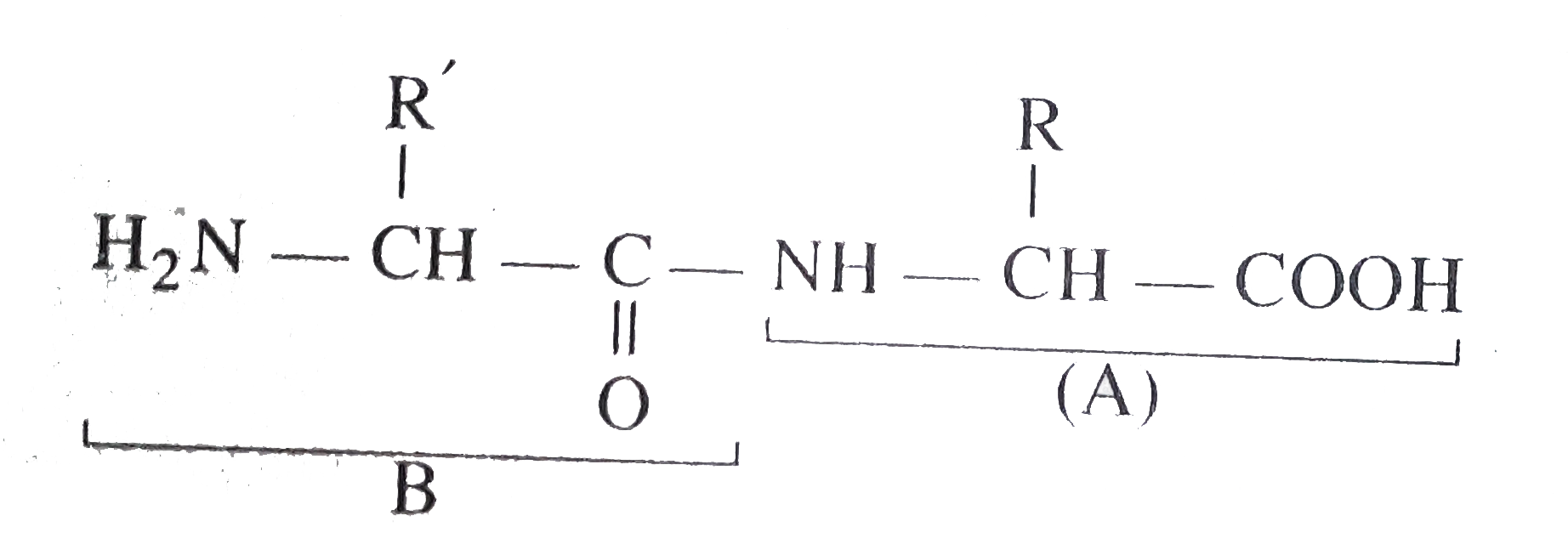
|
|
| 89941. |
A dipeptide does not have |
|
Answer» two peptide units |
|
| 89942. |
(A) Dioxygen does not react directly with Au and Pt ( R) au ad Pt are noble metals |
|
Answer» Both (A) and (R ) are true and (R ) is the CORRECT explanation of (A) |
|
| 89943. |
A diode is |
|
Answer» only n typeof SEMICONDUCTOR |
|
| 89944. |
(A) Dinitrogen is chemically inert (R ) Nitrogen has stable half filled p-subshell |
|
Answer» Both (A) and (R ) are TRUE and (R ) is the CORRECT explanation of (A) |
|
| 89945. |
A dilute solutions "x" moles of A in 1kg of solvent with molal elevation constant K_(b) . The solution dimerises in the solution . 2AhArr A_(2) (alpha be degree of association) The molecular weight observed will be : |
|
Answer» `i=1-2 ALPHA` |
|
| 89946. |
A dilute solution of which acid is most likely to produce a reduction product other than H_(2) when it reacts with a metal ? |
| Answer» ANSWER :C | |
| 89947. |
A dilute solution of KCl was placed between two platinum electrodes, 12 cm apart, across which a potential of 1.93 volts was applied. How far (in m) would the K + ion move in 20 h at 25^(@)C ? Ionic conductance of K + ion at infinite dilution at 25^(@)C is 7.5 xx 10^(-3) moh m^(2) mol^(-1) . |
|
Answer» or, `(7.5 xx 10^(-3))/(96500) = ("distance"//20 xx 3600)/(1.93//0.12)` `IMPLIES "distance" = 0.09 m`. |
|
| 89948. |
A dilute solution of litmus becomes colourless on shanking with charcoal. This is due to: |
|
Answer» Absorption |
|
| 89949. |
A dilute solution of KCl was placed between two platinum electrodes 10 cm apart, across which a potential of 6 volts was applied. How far would the K^(+) ion move in 2 hours at 25^(@)C ? Ionic conductance of K^(+) ion at infinite dilution at 25^(@)C is 73.52 "mho cm"^(2). |
|
Answer» |
|
| 89950. |
A dilute solution of H_(2)SO_(4) is made by adding 5 mL of 3N H_(2)SO_(4) to 245 mL of water. Find the normality and molarity of the diluted solution. |
|
Answer» |
|